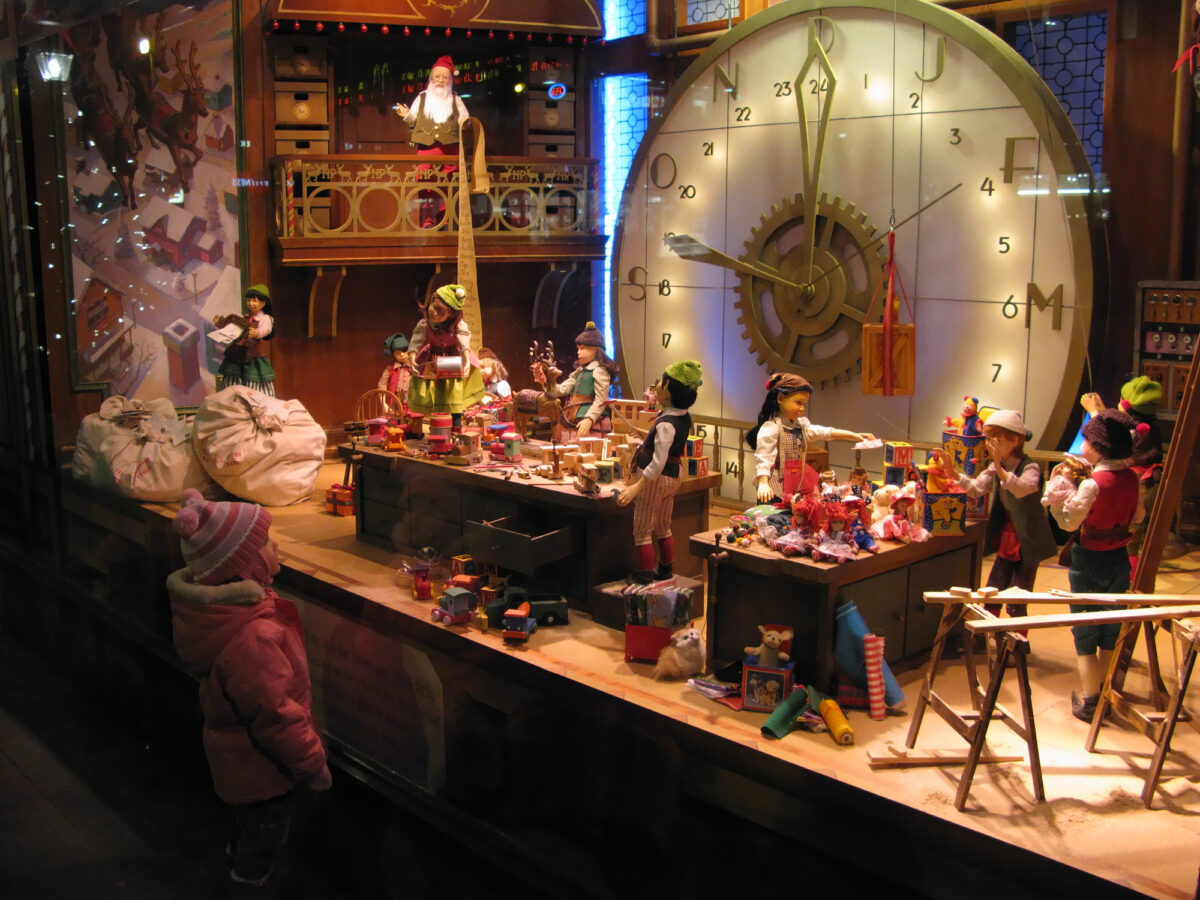
Photo by Allen McGregor via Wikipedia
For more information on how retailers are using mixed commerce solutions, check out our Mixed Commerce Glossary, which defines the terminology being used to businesses to describe the changes currently sweeping retail.
Virtual Reality and Augmented Reality are changing visual merchandising
Visual marketing has been a major component of retail sales since the mid-1800s, when Paris’ Le Bon Marche and New York’s Macy’s department stores first began wooing customers with innovative and eye-catching displays. Macy’s, in particular, was an early innovator thanks to their holiday windows and in-store appearances by Santa Claus.
Modern visual marketing techniques and store designs emerged at the turn of the 20th century, when giants like Marshall Field & Co. and Harry Selfridge began selling their wares direct to the general public. In the early days, fancy window displays and impressive architecture were enough to capture the public’s imagination, but in our fast-paced modern age it takes more than well-dressed mannequins visible from the street to bring in crowds of shoppers.
Today’s businesses are constantly adapting to this changing marketplace, and visual marketing now pervades every aspect of the sales experience. Just wander through an Ikea or any similar retailer and you’ll find staged room after staged room, where every item on display is for sale. It’s easier for the shopper to mentally picture a product as a part of their life when they can see it in what appears to be a real, functional setting.
Virtual Reality and Augmented Reality technologies are now disrupting traditional visual marketing by building on the innovative work of those early retail pioneers. The good news is that businesses and consumers alike are finding real value and utility in the new technology. But how are Virtual Reality and Augmented Reality making a difference in matching consumers with the products they want?
Here’s are 4 ways VR and AR improve upon traditional visual marketing:
1. VR and AR visual merchandising ideas: It’s the evolution of experiential marketing
The point of experiential marketing is to create a link between a customer and a brand by providing a entertaining or unique shopping experience, and businessman Harry Selfridge was one of the early pioneers. His chain of department stores spread across the UK in the early 1900s, thanks in large part to Selfridge innovations like allowing customers to examine products on display (imagine that!), moving the perfume counter to a prominent space on the main floor, and generally making the buying experience as easy and pleasurable as possible.
He was also highly quotable. The old saying, “The customer is always right” — yeah, that’s his.
The modern consumer is more savvy than those of 100 years ago, reducing the effectiveness of traditional marketing techniques like window displays. Modern merchants are running with Selfridge’s belief that the shopping experience should be enjoyable, and have been experimenting with Augmented Reality and Virtual Reality as a way to create a unique, fun buying experience, and to set themselves apart in the marketplace. By offering an experience that’s as entertaining as watching a movie or playing a video game, merchants who sell with VR and AR hope to increase sales and customer loyalty, while also building buzzy word of mouth from shoppers. After all, the more enjoyable the experience, the more likely the customer is to spend money — and tell a friend.
2. Data, data everywhere! Track every glance
Something else Harry Selfridge is quoted as saying is, “People will sit up and take notice of you if you will sit up and take notice of what makes them sit up and take notice.” This twisty piece of advice is one that today’s retailers — who live in a world ruled by big data — can’t afford to ignore. AR and VR platforms are constantly generating statistics on user behavior and activity, allowing merchants to better target the shopping experience to the individual consumer and convert more browsing to buying.
Beyond simply cataloguing shopper activity, future AR and VR platforms are expected to be more closely attuned to the user’s physiology, allowing for the tracking of emotional and physical responses that are not currently measurable. While this may sound a little “Big Brotherish” today, the health benefits of allowing technology to monitor our body on this very personal level will quickly outweigh any discomfort people feel at the potential loss of privacy. With mass adoption comes a huge opportunity for forward-thinking retailers.
3.Unlimited square footage and infinitely customizable
Businesses that sell cars, appliances, or any number of other large consumer goods know that showroom space is always at a premium. Warehousing all of that product can also be a challenge, with merchants spending significant sums of money on physical space when they could otherwise be funding product research and development. Until now, there’s been no real way for businesses to avoid the financial burden of staging their retail floor, seasonally updating displays and constantly adding and removing merchandise.
VR and AR systems allow for a fully customizable space that can be updated with speed and ease — significantly reducing both the cost and man-hours of regularly refreshing a store’s look. It’s now possible for a retailer to build seasonal templates for later use, allowing them to switch from a summer display to the fall with a touch of a button. Everything from outdated products to the physical look and feel of the space will be customizable and tailored to the experience the retailer wants to create for the customer.
4. Cost control: Reduce real costs related to logistics, loss and manufacturing samples
Though it may seem counterintuitive at first, the ability to pitch a potential client on an entire product line without the need for real, physical examples is a game-changer for retailers. Virtual Reality and Augmented Reality eliminate the need to keep expensive and bulky samples on hand, and no physical display means greatly reduced costs.
Traditional visual marketing requires the product being sold to be available for the customer to inspect and consider. Are there 10 different models for sale? Better have all 10 on hand in case the customer has a specific one in mind. But maintaining a showroom full of merchandise, or toting around dozens of samples to sales calls, is a costly and burdensome necessity. Virtual and Augmented Reality sales tools allow a merchant or account executive to offer a full demo of a product without having to haul in a bunch of samples.
The added efficiency and cost savings of VR- and AR-based visual marketing will be a huge boost to retailers, while the entertaining experience will keep shoppers coming back for more.












